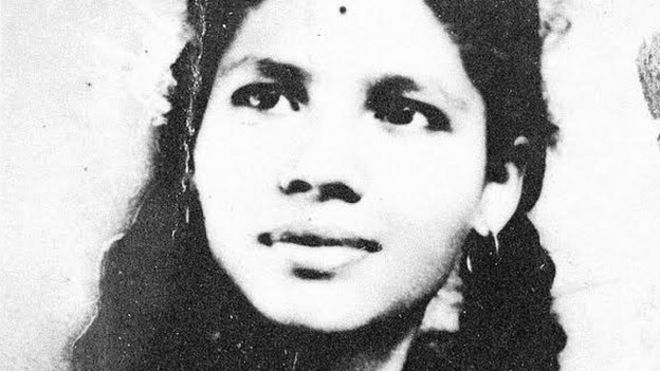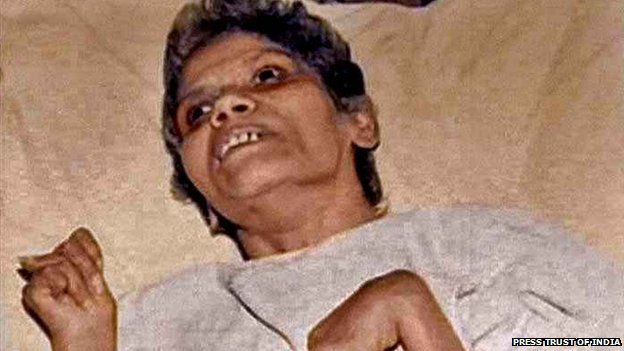- 18 May 2015
- India

An Indian nurse who spent 42 years in a persistent vegetative state after being raped and strangled has died.
Aruna Shanbaug was left with severe brain damage and paralysed after the 1973 attack by a ward attendant in the Mumbai hospital where she worked.
She was fed through the nose to keep her alive but developed pneumonia six days ago, the hospital told the BBC.
Her case sparked a debate about India's euthanasia laws. The Supreme Court had rejected a plea to allow her to die.
"Ms Shanbaug died at 08:30am on Monday. She was admitted to the intensive care unit and put on ventilator support," a spokesman at Mumbai's KEM hospital said.
The nurse was 25 years old when she was sodomised by a KEM hospital cleaner who strangled her with metal chains and left her to die on 27 November 1973.
She survived, but spent the rest of her life in hospital, force fed twice a day.
"My broken, battered baby bird finally flew away. And she gave India a passive euthanasia law before doing so," journalist and author Pinki Virani, who wrote Aruna's Story, a book on the nurse's plight, told the BBC.


Twitter reaction: 'Her pain will always shame us'
There is an outpouring of sympathy for Aruna Shanbaug on Twitter. Many feel that she "should have been allowed to go much earlier". Most Twitter users also agree that the absence of the "right to die" in India's legal system compounded her misery.
One Twitter user says Shanbaug's case "represents everything that is wrong with India's society".
Others highlight that she was brutally raped and then had to live in a vegetative state for 42 years because several campaigns in support of euthanasia "just fell on deaf ears".
Some say that her ordeal "will always shame India", while others are hopeful that her story will once again reignite the debate on euthanasia.
"Have mostly been ambivalent about euthanasia. But Aruna Shanbaug's case makes me want to take a stand. Misery should not last four decades," this tweet very much sums up the impact her story is likely to have on India's thinking on "right to die".

Ms Virani filed the case which was rejected by the Supreme Court in 2011. She had argued that Ms Shanbaug was "virtually a dead person" and should be allowed to die.
Ms Shanbaug's parents died many years ago and other relatives had not maintained contact with her, Ms Virani said.
She wanted the court to issue instructions to the hospital to stop feeding Ms Shanbaug.
But hospital authorities told the court that Ms Shanbaug "accepts food... and responds by facial expressions" and responds to "commands intermittently by making sounds".
Although the Supreme Court rejected Ms Virani's plea, the case resulted in India easing some restrictions on euthanasia after the court's landmark ruling that life support could be legally removed for some terminally ill patients in exceptional circumstances, providing the request was from family and supervised by doctors and the courts.
Doctors say patients in a vegetative state are awake, not in a coma, but have no awareness because of severe brain damage.
Lawyer Shekhar Nafade, who represented Ms Virani in the Supreme Court, told the BBC that he felt "relieved for Aruna".
Ms Shanbaug's attacker, Sohanlal Bharta Walmiki, was not even charged for raping her since sodomy was not considered rape under Indian laws at the time.
He was freed after serving a seven-year-sentence for robbery and attempted murder.
Ms Virani told the BBC in 2013 that she had tried hard to track him down, but with no success.
"I was told that he had changed his name and was working as a ward boy in a Delhi hospital. The hospital where he had sodomised Aruna and left her in this permanent vegetative condition had never kept a photo of him on file. Neither did the court papers," she said.

No comments:
Post a Comment